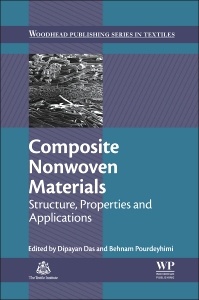Composite Nonwoven Materials Structure, Properties and Applications Woodhead Publishing Series in Textiles Series
Auteurs : Das Dipayan, Pourdeyhimi Behnam

Composite nonwoven materials are versatile materials with a variety of applications, including hygiene, medicine and filtration. This important book provides a technical resource for professionals and academics in the field. It explores these materials in terms of fiber types used, manufacturing processes, structure, and physical properties.
The first part of the book focuses on the use of natural and synthetic fibers in composite nonwovens, discusses their structure in terms of fiber packing and alignment, and their physical properties. Further chapters deal with the practical applications of composite nonwoven materials. Hygiene applications, such as diapers, female sanitary products, incontinence pads, and wipes are covered, as well as composite nonwoven-based medical products and filters.
Composite Nonwoven Materials is an ideal reference for R&D managers in the textile industry and academic researchers in textile science.
- Contributor contact details
- Woodhead Publishing Series in Textiles
- Chapter 1: Introduction to composite nonwovens
- Abstract:
- 1.1 Introduction
- 1.2 Classification of composite nonwovens
- 1.3 Processing, markets and applications
- 1.4 Conclusion and future trends
- 1.5 Sources of further information and advice
- Chapter 2: Natural and synthetic fibres for composite nonwovens
- Abstract:
- 2.1 Introduction
- 2.2 Natural and biodegradable fibres for nonwovens
- 2.3 Polypropylene and polyester fibres
- 2.4 Polyethylene and nylon fibres
- 2.5 Bicomponent fibres
- Chapter 3: Structure of composite nonwovens
- Abstract:
- 3.1 Introduction
- 3.2 Fibre characteristics in composite nonwovens
- 3.3 Fibre packing in composite nonwovens
- 3.4 Fibre orientation in composite nonwovens
- 3.5 Pore characteristics in composite nonwovens
- 3.6 Conclusion
- 3.7 Sources of further information and advice
- Chapter 4: Properties of composite nonwovens
- Abstract:
- 4.1 Introduction
- 4.2 Mechanical properties of composite nonwovens
- 4.3 Fluid permeability of composite nonwovens
- 4.4 Thermal properties of composite nonwovens
- 4.5 Liquid sorption characteristics of composite nonwovens
- 4.6 Particle filtration behaviour of composite nonwovens
- 4.7 Conclusion
- 4.8 Sources of further information and advice
- Chapter 5: Composite nonwovens in absorbent hygiene products
- Abstract:
- 5.1 Introduction
- 5.2 Key material requirements
- 5.3 Baby diapers
- 5.4 Feminine sanitary pads
- 5.5 Adult incontinence pads
- 5.6 Conclusion and future trends
- 5.7 Sources of further information and advice
- Chapter 6: Composite nonwovens in wipes
- Abstract:
- 6.1 Introduction
- 6.2 Materials in wipes
- 6.3 Wet wipes
- 6.4 Web forming technologies for wipes
- 6.5 Web bonding processes for wipes
- 6.6 Surface texturing of wipes
- 6.7 Composite nonwoven wipes
- 6.8 Multi-fibre composite nonwoven wipes
- 6.9 Multilayer composite latex bonded nonwoven wipes
- 6.10 Hydroentangled (spunlaced) multilayer composite nonwoven wipes
- 6.11 Thermobonded multilayer composite nonwoven wipes
- 6.12 Needlepunched composite nonwoven wipes
- 6.13 Other multilayer nonwoven wipes
- 6.14 Conclusion and future trends
- Chapter 7: Composite nonwovens in filters: theory
- Abstract:
- 7.1 Introduction
- 7.2 Mechanisms of filtration: general
- 7.3 Mechanisms of filtration: particle capture entrapment
- 7.4 Adsorption
- 7.5 Absorption
- 7.6 Coalescing
- 7.7 Media for gel removal
- 7.8 Mechanisms of filtration: electro-filtration
- 7.9 Separation by antimicrobial media
- 7.10 Extraction
- 7.11 Key requirements for filtration media
- 7.12 Characteristics of nonwoven filters
- 7.13 Types of nonwoven filter
- 7.14 Conclusion
- Chapter 8: Composite nonwovens in filters: applications
- Abstract:
- 8.1 Introduction
- 8.2 The role of composite nonwovens in filters: combining mechanical support and durability with filtration
- 8.3 The role of composite nonwovens in filters: providing two or more layers of different filtration efficiency
- 8.4 The role of composite nonwovens in filters: combining different separation technologies/functionality into one filter medium
- 8.5 Applications of composite nonwovens
- 8.6 Applications in air/gas filtration
- 8.7 Applications in liquid filtration
- 8.8 Applications in engine filtration
- 8.9 Conclusion
- Chapter 9: Composite nonwovens in medical applications
- Abstract:
- 9.1 Introduction
- 9.2 Surgical gowns
- 9.3 Surgical facemasks and other clinical wearable products
- 9.4 Wipes
- 9.5 Wound dressings, pads and swabs
- 9.6 Scaffolds for tissue engineering
- 9.7 Hernia meshes
- 9.8 Filtration materials for medical applications
- 9.9 Incontinence products
- 9.10 Conclusion and future trends
- 9.12 Appendix: recent patents based on composite nonwovens for medical applications
- Index
Behnam Pourdeyhimi is a Professor at North Carolina State University, USA
- Systematic and comprehensive information on composite nonwovens
- Critical review of progress in research and development on composite nonwovens
- Comment on future research direction and ideas for product development
Date de parution : 03-2014
Ouvrage de 252 p.
15.5x23.2 cm
Épuisé



